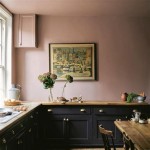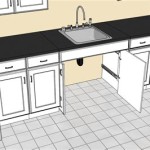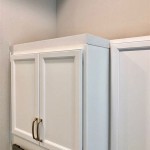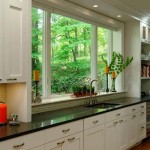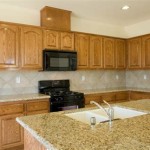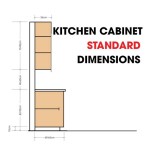Choosing Colors For Kitchen Cabinets: A Comprehensive Guide
The kitchen, often hailed as the heart of the home, serves as a focal point for culinary creativity and social gatherings. As such, the aesthetic appeal of the kitchen significantly impacts the overall ambiance of the living space. Among the various design elements within a kitchen, cabinets hold a prominent position, both visually and functionally. The color of kitchen cabinets plays a vital role in setting the tone and style of the entire room. Selecting the right colors requires careful consideration, balancing personal preferences with design principles to achieve a harmonious and visually pleasing result.
This guide explores various aspects of choosing colors for kitchen cabinets, providing insights into current trends, classic choices, and practical considerations. It delves into the psychology of color, explores different color families, and offers tips for coordinating cabinet colors with other kitchen elements, providing a comprehensive understanding of the factors involved in making informed color decisions.
Understanding the Role of Color Psychology in Kitchen Design
Color psychology explores the impact of colors on human emotions and behaviors. Different colors evoke different feelings and associations, and understanding these effects can be valuable when choosing colors for kitchen cabinets. The kitchen is a space for creativity, nourishment, and social interaction, so selecting colors that align with these activities is crucial.
For instance, warmer colors, such as yellows, oranges, and reds, are often associated with energy, warmth, and appetite. They can create a cozy and inviting atmosphere, making the kitchen feel more welcoming. However, these colors can also be stimulating and potentially overwhelming if used excessively. Cooler colors, such as blues, greens, and purples, are generally associated with calmness, serenity, and sophistication. They can create a relaxing and tranquil atmosphere, making the kitchen feel more spacious and airy. However, these colors can also feel cold or sterile if not balanced with warmer tones.
Neutral colors, such as whites, grays, and beiges, provide a versatile backdrop that allows other elements in the kitchen to stand out. They are timeless and adaptable, working well with various design styles. Neutral colors can also be combined with bolder accent colors to create visual interest and personality. The specific shade and undertone of a color also play a significant role. A warm white, for example, will have a different effect than a cool white. Similarly, a muted green will create a different mood than a vibrant green. Therefore, it is essential to carefully consider the nuances of each color before making a final decision.
Exploring Different Color Families for Kitchen Cabinets
The range of colors available for kitchen cabinets is vast, offering endless possibilities for creating a unique and personalized space. To simplify the selection process, it can be helpful to categorize colors into different families, each with its own distinct characteristics and aesthetic qualities.
Whites and Off-Whites: White cabinets are a classic and timeless choice, offering a clean, bright, and versatile look. They reflect light effectively, making the kitchen feel more spacious and airy. White cabinets also provide a neutral backdrop that allows other design elements, such as countertops, backsplashes, and hardware, to stand out. Off-white shades, such as cream, ivory, and antique white, offer a softer and warmer alternative to pure white. These shades can add a touch of elegance and sophistication to the kitchen, while still maintaining a bright and airy feel. The specific shade of white or off-white should be carefully chosen to complement the other colors and materials in the kitchen.
Grays: Gray cabinets have gained popularity in recent years, offering a sophisticated and modern alternative to white. Gray is a versatile color that can range from light and airy to dark and dramatic. Light gray cabinets can create a calming and relaxing atmosphere, while dark gray cabinets can add depth and richness to the space. Gray cabinets work well with a variety of countertop materials, including granite, quartz, and wood. They also complement a wide range of hardware finishes, such as stainless steel, black, and brass. Choosing the right shade of gray depends on the overall design style of the kitchen and the desired mood.
Blues: Blue cabinets can bring a sense of tranquility and sophistication to the kitchen. Light blue cabinets can create a coastal or cottage-style feel, while dark blue cabinets can add a touch of drama and elegance. Blue cabinets pair well with white countertops and backsplashes, creating a crisp and clean contrast. They also complement natural wood tones, adding warmth and texture to the space. The specific shade of blue should be chosen carefully to avoid overwhelming the space or creating a cold and unwelcoming atmosphere.
Greens: Green cabinets can bring a sense of nature and freshness to the kitchen. Light green cabinets can create a soothing and relaxing atmosphere, while dark green cabinets can add a touch of richness and sophistication. Green cabinets work well with natural materials, such as wood and stone. They also complement earthy tones, such as brown and beige. The specific shade of green should be chosen carefully to ensure that it complements the other colors and materials in the kitchen and creates a cohesive and harmonious look.
Wood Tones: Natural wood cabinets offer a warm and inviting look, adding texture and character to the kitchen. Wood cabinets can range from light and airy to dark and rustic, depending on the type of wood and the finish. Light wood cabinets, such as maple and birch, can create a bright and Scandinavian-inspired feel, while dark wood cabinets, such as cherry and walnut, can add a touch of elegance and formality. Wood cabinets work well with a variety of countertop materials, including granite, quartz, and concrete. They also complement a wide range of hardware finishes, such as brass and black. The specific type of wood and finish should be chosen carefully to complement the overall design style of the kitchen and the desired aesthetic.
Practical Considerations for Choosing Kitchen Cabinet Colors
Beyond aesthetic preferences, several practical considerations should be taken into account when choosing colors for kitchen cabinets. These factors can impact the longevity, maintenance, and overall functionality of the kitchen.
Kitchen Size and Lighting: The size and lighting of the kitchen play a significant role in determining the most suitable cabinet colors. In smaller kitchens, lighter colors are generally preferred, as they reflect light and make the space feel larger and more open. Darker colors can make a small kitchen feel cramped and claustrophobic. However, if the kitchen receives ample natural light, darker colors can be used effectively to add depth and drama. Artificial lighting should also be considered, as different types of light can affect the appearance of colors. Warm lighting can enhance warm colors, while cool lighting can enhance cool colors. It is essential to test cabinet color samples under different lighting conditions to ensure that the chosen colors look appealing in the kitchen.
Maintenance and Durability: The color of kitchen cabinets can also impact their maintenance and durability. Lighter colors tend to show dirt and stains more easily than darker colors, requiring more frequent cleaning. Darker colors, on the other hand, can show scratches and fingerprints more readily. Matte finishes are generally more forgiving than glossy finishes, as they tend to conceal imperfections better. The durability of the cabinet finish is also a crucial consideration, especially in high-traffic areas. High-quality finishes that are resistant to scratches, stains, and moisture are essential for ensuring the longevity of the cabinets.
Coordinating with Existing Elements: Kitchen cabinets should complement the other elements in the kitchen, such as countertops, backsplashes, flooring, and appliances. Choosing cabinet colors that coordinate with these elements can create a cohesive and harmonious look. For example, if the countertops are made of granite with warm undertones, choosing cabinet colors that also have warm undertones can create a unified design. Similarly, if the backsplash is made of a colorful tile, choosing cabinet colors that complement the tile can create a visually appealing contrast. It is essential to consider the existing elements in the kitchen when choosing cabinet colors to ensure that the overall design is balanced and aesthetically pleasing.
Current Trends and Timelessness: While it is tempting to follow the latest trends in kitchen design, it is also important to consider the timelessness of the chosen colors. Kitchen cabinets are a significant investment, and choosing colors that will remain appealing for years to come is crucial. Classic colors, such as white, gray, and natural wood tones, are generally considered to be timeless and versatile. However, incorporating trendy accent colors can add a touch of personality and modernity to the kitchen without compromising its long-term appeal. It is essential to strike a balance between following current trends and choosing colors that will stand the test of time.
Ultimately, choosing colors for kitchen cabinets is a personal decision that should reflect individual preferences and lifestyle. By considering the factors outlined in this guide, individuals can make informed decisions and create a kitchen that is both functional and aesthetically pleasing.

Top Kitchen Cabinet Color Trends For 2024 Colors Cabinets Combination

Trending Kitchen Cabinets Colour Schemes Of 2024 Design Cafe

A Beginner Friendly Comprehensive Guide To Kitchen Cabinet Colors

How To Choose A Kitchen Cabinet Color According Designers

How To Choose Kitchen Cabinet Paint Colors

30 Best Kitchen Color Ideas And Combinations 2024

14 Kitchen Cabinet Color Combinations To Try

The 9 Big Kitchen Cabinet Color Trends Of 2024 With Paint Colors Kaitlin Madden

How To Choose Kitchen Cabinet Color Awa Cabinets

Trending Kitchen Cabinets Colour Schemes Of 2024 Design Cafe Combination Interior Small Laminate Color
Related Posts

